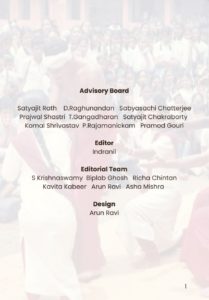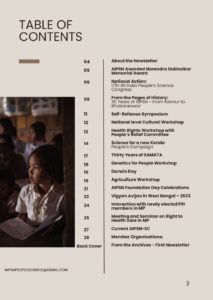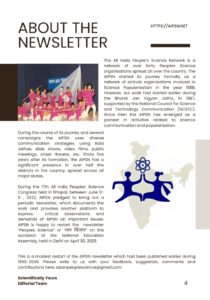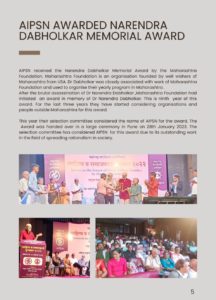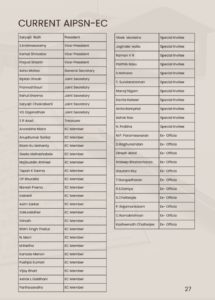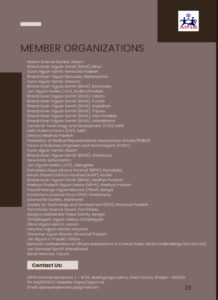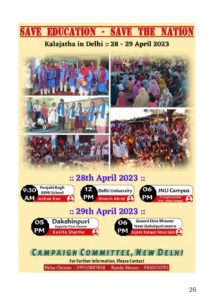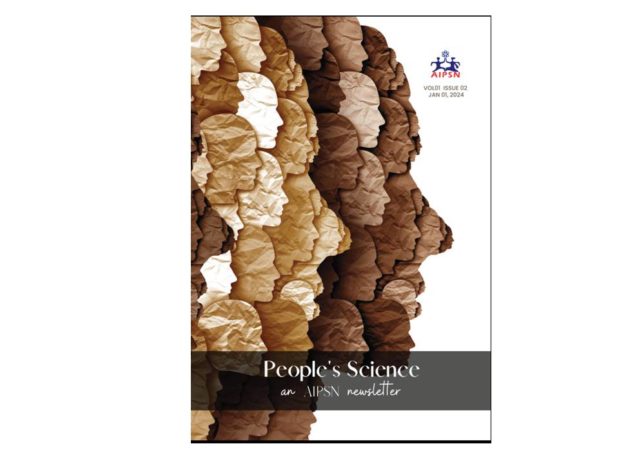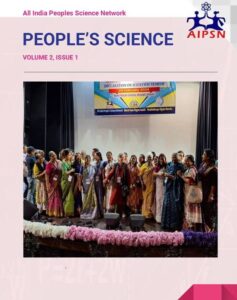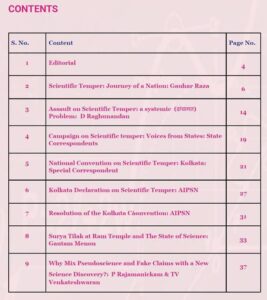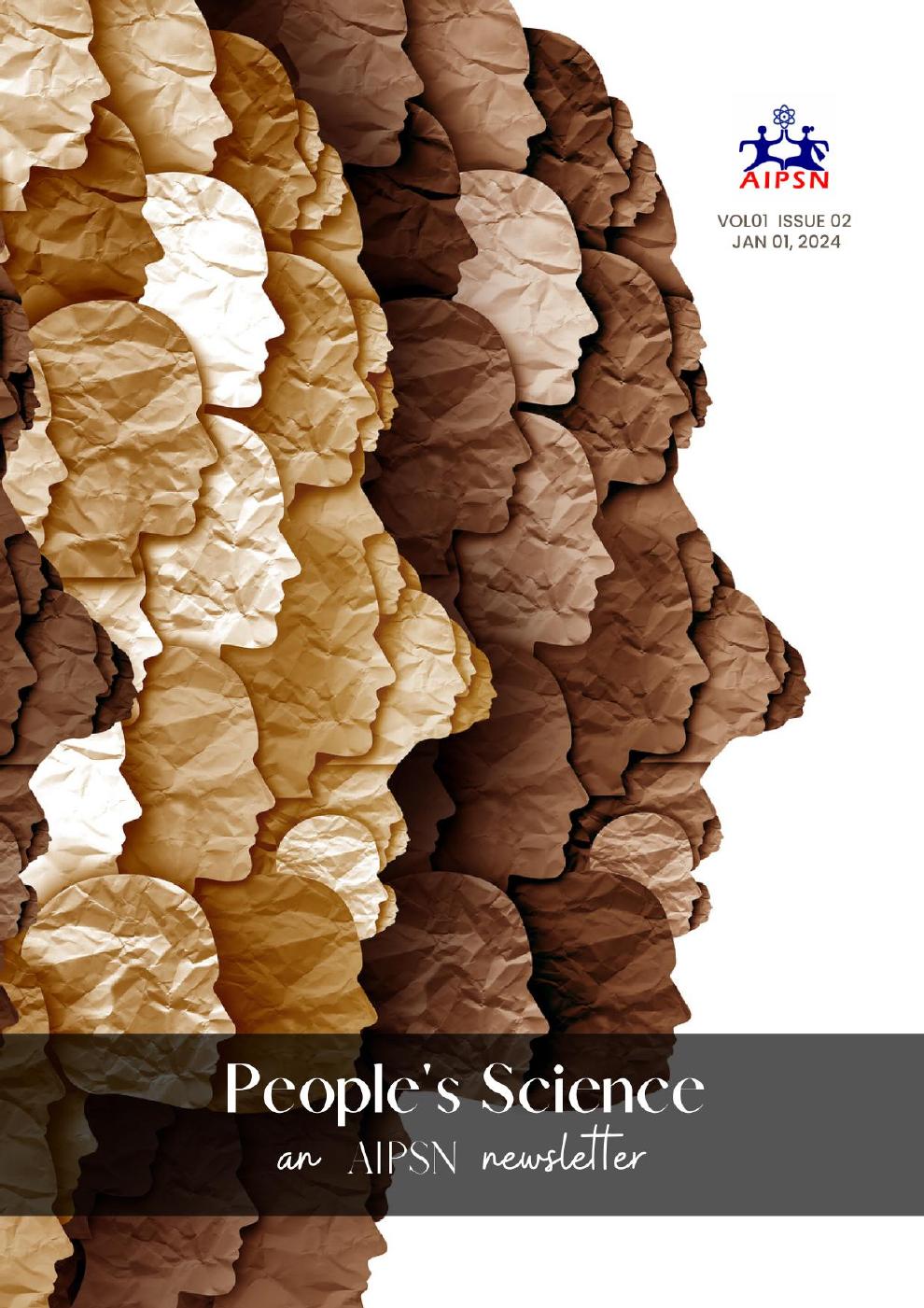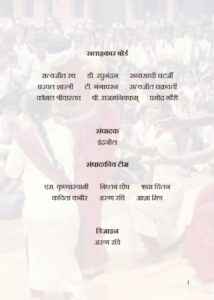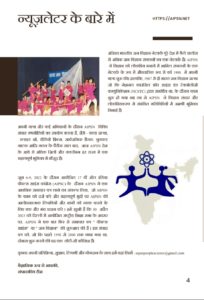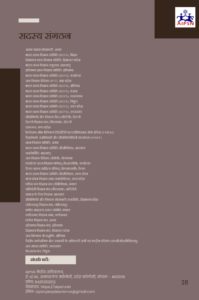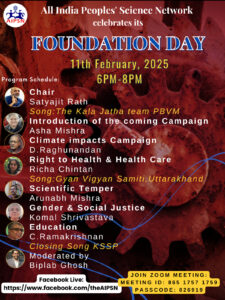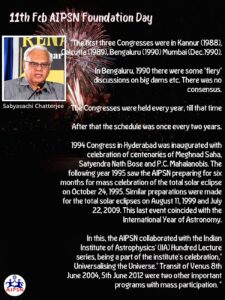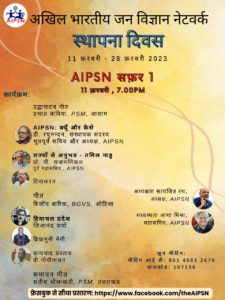Background Paper
AIPSN Campaign on 75 Years of Independence
75 Years of Independence: Self Reliance, Idea of India and Road to the Future
Independent India was born on 15th August 1947 with the end of British colonial rule and unfurling of the tri-colour on the ramparts of the Red Fort in Delhi by the new nation’s first Prime Minister Jawaharlal Nehru. India’s journey over the next 75 years has been remarkable by any standards, but with many ups and downs along the way. While there is much to celebrate, there is also much to be disappointed about. Also, unfortunately, perspectives and actions under the current political dispensation are posing serious challenges to the very foundations of our nation laid during the freedom struggle, threatening the edifice of the Constitution and the very Idea of India forged collectively by the people’s movement for Independence and the efforts towards building of independent India. In this the 75th year of Independence, the Peoples Science Movement looks at how our independent nation started, what was achieved, what went wrong and what prospects and challenges lie ahead in the future.
Early years
Born out of the values and ideas forged during the freedom movement, and the wholehearted participation of all sections of the people, India as a poor, developing and highly diverse country with a massive poverty and deprivation burden, low literacy rates, poor health and other human development indicators, embarked on a path rarely seen among newly-independent nations of the time. The path India adopted comprised several core ideas of nationhood such as universal voting rights; equality of all citizens before the law; a secular state without discrimination between religions, castes, languages, ethnicities or gender; the idea of unity in this diverse country of multiple cultures and traditions; freedom of expression and plurality of opinion; and a commitment to build a modern welfare state with a citizenry imbued with scientific temper and critical thinking.
India’s Constitution adopted in 1950 including many subsequent amendments by the legislature, further advanced these Ideas of India in both concept and practice by the political executive i.e. the government, the legislature and the judiciary, and provided an institutional framework for democratic governance and safeguarding citizens’ rights. The Constitution provided for a popularly accountable and federated system of governance involving the Union of India and its States. It also provided for checks and balances, separation of powers between an independent legislature, executive and judiciary, as well as strong institutions of governance with autonomy from the political executive. The world watched in wonder and praised India as it progressed along this path, managing arguably one of the most socio-culturally diverse and complex countries, undoubtedly with many hiccups along the way.
Independent India adopted a policy framework of building a strong industrial base based on scientific and technological (S&T) self-reliance and public sector enterprises in core sectors of the economy, helping the country build an independent industrial base, and also build its own capabilities across sectors. Western countries with their neo-colonial mindsets by and large did not help India in this process of industrialization, whereas the then Soviet Union extended considerable assistance in basic and heavy industries especially through public sector units (PSU) in steel, petroleum, electricity and power generation equipment, coal, mining and related machinery, heavy machines, pharmaceuticals etc including through technology transfer and R&D efforts to support India’s efforts to achieve self-reliance.
With a special determination, India also built capabilities, knowledge and technologies in frontier areas of space and atomic energy, as well as to a lesser extent in defence in collaboration with many countries and overseas companies. This enabled India to maintain strategic autonomy from major foreign powers and to play a leading role in building the Non-Aligned Movement along with most newly-independent and developing countries and other nations. The adoption by Parliament of the Industrial Policy Resolution in 1956 and the milestone Scientific Policy Resolution of 1958, a first such document among nations which heralded S&T-based enterprises and the obligation of the State to build a scientific temper among its citizens, underscored this trajectory of S&T self-reliance, economic progress and human resource development structured around modern industries in core sectors. Premier public institutions of research and higher education were established in the early post-Independence years, such as the Tata Institute of Fundamental Research and the Bhabha Atomic Research Centre, the Indian Institute of Science, Bangalore, and several IITs in collaboration with different countries as a crucial part of this endeavour.
The 1948 Bombay Plan prepared by private sector leaders had agreed that the state should take the lead in the core sector especially heavy industries, since the private sector did not have either the capital or the capability required. Private companies would then concentrate on consumer goods and light industries. Contrary to some propaganda and public perceptions, this perspective was not simply the result of a Nehruvian “socialist” vision, but the result of considered thinking by the captains of Indian industry and commerce.
This industrial foundation, along with central planning, propelled the country forward to a leading position among developing countries in the first few decades after independence.
Together, these bestowed India with an enviable position in the international community, substantial soft power and respect in the comity of nations.
Despite these strengths, several lacunae in both conception and implementation may be noted in this early period, many of which persisted in successive decades.
In the agreed division of industrial responsibilities, the private sector did not develop substantial autonomous capabilities and were content with protectionist policies against imports and entry of foreign firms, and profited from a captive domestic market for low-quality, low volume, uncompetitive goods. Thus the private sector did not make much contribution to self-reliance or national industrial advancement with only a few exceptions. Unfortunately, this tendency persists even to this day. While private sector companies have pushed their way into sectors formerly earmarked for the state sector, they have still not built autonomous domestic capabilities or invested in R&D and self-reliance, preferring foreign collaborations and lower-end technologies.
Agriculture was seriously addressed only in the 1960s in the 4th five-year Plan through the Green Revolution. The programme was a huge success as regards raising food grain production substantially, and almost eliminating major cereals imports. However, the high inputs strategy brought with it with many negative aspects as discussed in the next section, leaving major issues yet to be addressed in agriculture.
Low investment in school education and primary health held back the already impoverished masses, slowed the pace of development, and prevented the people especially the poor from achieving their true potential. Despite many efforts at different points of time, substantial weaknesses persist in social infrastructure.
In the period under discussion, industrial development was stagnating as noted earlier, unable to generate higher productivity and employment despite the protected economy.
The Middle Decades: hits and misses
Governments in the later 1960s to the 1980s undertook several initiatives to address the deficits mentioned above. It is useful to examine the successes and failures of this period in some detail, since it was followed by a prolonged period of neo-liberal policies till the present and enables an informed comparison.
Public sector industries continued their dominant position in the economy, but did not sufficiently modernize to the next generation of technologies that were already establishing a strong presence in the global economy but were constrained within a limited framework of import substitution. The private sector continued to flourish but in a heavily protected domestic market and, while complaining of a “license-permit raj” imposed by government, made little effort to overcome these constraints, as shown by the under-development of light engineering and consumer goods industries during these decades. In the context of economic and technological developments, especially in comparable economies in East and South-East Asia which were broadly on par with India in terms of development in the ‘60s and ‘70s, it is no surprise that the period is described as the “lost decade.” Combined with developments after liberalization of the Indian economy, the missed opportunities of this period, raises serious issues about what India needs to do in the contemporary context to at least catch up with other countries as regards self-reliance S&T in the knowledge era.
Several progressive economic measures were initiated during this period. While Insurance had been nationalized much earlier in 1956, 14 major Banks were nationalized in 1969, providing stable financial underpinnings to development, and extended banking services as well as credit availability to hitherto unserved sections, especially in rural areas. Many experts and commentators doubt if opening up of banking to the private sector since liberalization of the economy has been beneficial to the people especially in rural areas or to the economy as a whole.
Rural poverty was explicitly addressed only in the 5th five-year plan, notably through the then government’s “garibi hatao” programme and several poverty alleviation schemes such as IRDP, TRYSEM, SGSY and related self-employment Schemes over the next few Plans. Unfortunately even these could not achieve their objective, with some official evaluations showing that only 14% of beneficiaries were enabled to go above the poverty line, however without any assessment of how many later dropped below it later. It was only much later, under the UPA Government in 2006-10, that the effective demand-driven MNREGA wage-employment Scheme, which was introduced through enormous push by progressive forces and civil society organizations, provided much relief for the rural un-/ under-employed and which proved its usefulness during the pandemic. Yet rural-urban disparities and large-scale unemployment or under-employment persist to this day as structural problems.
The Asian Experience
During the 1970s and early 1980s, other South East Asian countries, who were at a par with India a decade earlier, galloped ahead economically and in human development indicators through rapid development of indigenous S&T capabilities in mass manufacturing, white goods, electronic goods, micro-chips and computers.
In Japan or South Korea this was not just a giant leap forward in manufacturing, but was built by domestic companies and product brands, mostly without foreign collaboration, supported by both applied and basic research such as in particle physics, materials, electronics, optics etc and was backed by substantial policy planning and financial support by their respective governments.
These experiences showed that the concept of self-reliance was not some antiquated “socialist” idea, but a practical policy for nations wishing to establish their strong and independent presence in the world economy, and developing the capability to deal with the next technological shift. These experiences have all shown the value of self-reliance and indigenous capability, which are not merely means to developing the domestic economy, but a means towards playing a leading role in the global economy instead of remaining dependent on others or playing a junior role lower down in the value chain.
It should also be noted that these SE Asian countries consistently invested around 4-5% or more of GDP on R&D, education and health. In comparison, India’s investments in these three areas continue to languish at around 1-2%. Things got no better in the 1990s or the decades thereafter, including after 2014 when grandiose promises were made to take India into the 21st century or become a developed country by 2025 or become a $5 trillion economy soon.
Agriculture
Agriculture was another sector relatively neglected in the early post-Independence decades, but continuing low food grain production, several near-famine years, and a devastating and frankly humiliating dependence on food aid notably from the US, prompted a major push to augment food grain production in the late 1960s onwards in the form of the so-called Green Revolution (GR). The new policy, supported by substantial financial and technological assistance from international organizations and developed countries especially the US, was focused on wheat and rice in the fertile and irrigated areas of Punjab, Haryana and West UP, and was based on high inputs of specially-developed high-yielding varieties, irrigation water, inorganic fertilizers and pesticides, and mechanization of operations. The policy brought dramatic improvements in wheat and rice production, and saw India become a major agricultural producer in the world and move towards minimal imports in only a few agricultural produce. Total production of food grains increased from 51 million tonnes in 1950-51 to close to 300 million tonnes at present with huge increases in yield per hectare, multiple crops each year and expansion of acreage under cultivation. GR therefore undoubtedly transformed food grain production and agriculture in general in India, but brought along with it many negative consequences now being felt in the country and which will haunt the country for decades to come unless several corrective measures are urgently taken.
Overuse of chemical fertilizers and new farming practices have resulted in serious depletion of soil health with related productivity losses. Over irrigation especially through excessive use of groundwater has resulted in severe depletion of water resources and water-logging. High input costs including mechanization have skewed agriculture in favour of larger farmers and have also led to high indebtedness. The emphasis on HYV of wheat and rice has led to loss of biodiversity especially indigenous varieties, besides sharp decrease in cultivation of millets and other ‘coarse’ grains to the detriment of nutritional status, crop diversification and over-reliance on just two crops with impact on returns. The recent farmers’ agitation over the government’s so-called agricultural “reforms” has been prompted in large part by the skewed socio-economic impacts of the Green Revolution.
GR has had several other undesirable impacts too. The policy was implemented vigorously through the active involvement of agricultural universities who contributed greatly in terms of S&T but also became deeply inter-twined with issues of rich farmers, mechanized and industrial farming and linkages with Western institutions. The famously successful system of extension workers that spread the message and practices of the GR collapsed when the main task was over and was never replaced, leaving farmers dependent on mostly MNC agri-businesses for extension services.
Other regions were neglected due to the overwhelming emphasis on the north-western states although a few sub-regions in the eastern Gangetic basin did benefit. However, crops other than wheat and rice, and agriculture in rainfed areas accounting to around 65% of farmers were not given due attention, even though the “brown revolution” or the ‘second green revolution” are bandied about. This has seen the continued neglect and impoverishment of eastern India, as well as to the narrowing of the food basket especially of poorer people.
It should be underlined that despite the much heralded success of the GR, and the “self-sufficiency” that India has supposedly attained, a large proportion of the Indian people still go to sleep hungry and do not get two square meals a day. According to a 2021 FAO Report, about 15% of India’s population or about 195 million people, are undernourished and ranks 101 out of 160 countries according to the World hunger Index 2021, ranking lower than Bangladesh (76) and Pakistan (92). All these reports indicate that India may not meet the millennium Development Goal of “zero hunger” by 2030. Clearly, the problems are not restricted to food production alone, but are related to socio-political policies governing inequalities and access.
These deficiencies and the negative consequences on Indian agriculture subsequent to the GR need to be addressed urgently, particularly R&D in raising productivity in rainfed areas, building climate resilience, and redressing the inequalities in food consumption and nutrition.
Environment
One sector where considerable effort and new initiatives were taken, which were not envisaged during the independence movement or during the first two post-Independence decades, was in environmental protection, conservation and regulation. This is hardly surprising since sensitivity to environmental issues had barely entered public consciousness, leave alone governance, in any part of the world, except for the forest conservation movement in Britain and colonial India in the 18th and 19th centuries and later in the US in order to ensure continued supplies of timber, and the setting up of nature and wildlife sanctuaries and national parks in the US in the early 20th century. The Club of Rome in the 1960s warned about the potential exhausting of the mineral resources that were the foundation of capitalism, but the panic was short-lived as capitalism itself evolved. However, the 1972 United Nations Conference on the Human Environment in Stockholm, Sweden, for the first time brought the environment and its linkage with human development into governance concerns, and institutionalized international discussions and diplomacy on environmental regulation.
Then Prime Minister Indira Gandhi, the only head of government to attend the historic summit, was said to have been deeply influenced by it, and initiated several policy measures in India broadly in tune with the Stockholm recommendations and those of other related global conferences. However, there is strong evidence supported by scholars that environmental regulations in India have evolved in response to both international diplomacy and, even more so, to pressure from civil society and social movements within the country. After Stockholm, the then government enacted a series of laws including major amendments to the Constitution as part of the series under the 42nd Amendment. Article 48A under Part IV obliges the state to protect and preserve the environment, while Article 51A (g) assigns citizens to do the same. The Air Act 1981, the Environment Protection Act 1986 and the Water Act 1976 also followed.
At the same time, the Chipko movement, the Silent Valley movement, and the movement to protect and advance forest rights of tribals and forest dwellers, all catalyzed major legislation, while the Bhopal Gas Tragedy, in which the Peoples Science Movement played a major role, catalyzed a raft of legislations and regulations governing industrial pollution, hazardous materials etc. All these movements broadened the scope of peoples participation in decision-making on developmental projects through mechanisms such as mandatory public hearings.
However, from the outset, environmental policies and their implementation in India have had a mixed record, as a result of pressure from corporate interests and supporting political and bureaucratic forces, and inadequate push from mainstream political formations for environmentally sustainable development policies. Despite victories in many battles for popular movements, the longer war continues and environmental regulations remain a theatre of daily confrontation calling for constant vigil by civil society and peoples movements such as the PSM. Forest rights continue to be threatened to this day, industrial accidents including those involving hazardous materials continue to occur due to lax if not collusive regulatory bodies. At present, environmental regulations are under severe attack, threatening the hard-won rights, laws and regulatory systems put in place over the decades. The intention, and the impact, is that the natural environment is being severely damaged, along with the lives and livelihoods of millions of people dependent upon it such as tribal people, other forest dwellers, fishers and many others.
Education
Investments in education, primary health and R&D continued to stagnate or even decline in real terms. Both in school and higher education the private sector expanded rapidly at the expense of the public system, including in rural areas. Private universities especially in engineering and medicine also proliferated with poor planning or regulation, leading to malpractices such as capitation fees, deficiencies in reservation, poor infrastructure and quality of education resulting in high unemployment or under-employment of graduates and, later, to closures leaving students in the lurch.
Ill-effects of the major failures during the early post-Independence decades in social infrastructure investments notably in health and education as noted earlier have become entrenched over the decades and have been worsened by the neo-liberal tendencies of withdrawal of the state from social services, and their privatization and commercialization.
The public education system certainly expanded in early decades after independence till India established the world’s second largest school system after China. However, despite all the attempts over the decades, and several new initiatives or special thrust programmes taken up from time to time, progress towards universal, free and compulsory education has been unsatisfactory in overall terms in both quantitative and qualitative terms. While enrolment rates in elementary stages have climbed steadily, crossing 90% about a decade ago, enrolment at higher stages of the education system have continued to drop off substantially to around 50% at the secondary stage, skewed even worse for female students. Teacher-student ratios are low and many surveys have shown quality of school education to be poor. Due to these weaknesses, and preferences and trend-setting by the middle-classes, private education has made major inroads over the years especially in secondary education, with enrolments in often English-medium private schools or even unrecognized private schools increasingly sharply in recent years at the cost of the public school system, including in rural areas, despite the regulations of the RTE Act of 2009 which, for the first time, made free education a constitutional right for children from 6 to 14 years of age. Inequalities between urban and rural areas, between better off and poor students, and between upper and lower castes have become deeply ingrained in the education system in India including at school level. These trends have only worsened in most States with the onset of neo-liberal economic policies and the withdrawal of the state from both social and physical infrastructure. The new National Education Policy (NEP 2020), with its added and strong emphasis on privatization and virtual on-line education will mostly amplify these deficiencies in education and in higher education as well, making these the Achilles heel for India’s future.
Health
A public health system to deliver primary health care was, and remains, another major developmental and welfare measure which was neither taken up strongly in the early post-independence period nor strengthened later to make up for earlier failures. Till today, this remains one of the largest and most glaring failures of the 75 years of Indian independence, as starkly evidenced by India lagging behind even several of our neighbours in South Asia and other low-income countries as regards basic health indicators. In 2016, India ranked 145 out of 195 countries in a Health Care Quality Index reported in The Lancet in 2019, with a score of 41.2 improving considerably from 1990 but still well below the global average of 54.4, and still ranking below Bangladesh and Bhutan, sub-Saharan Sudan and Equatorial Guinea.
Health was unfortunately not accorded adequate priority in the early post-Independence decades and was not recognized as a constitutional even later as was done for RtE, despite the strong and detailed recommendations of the Bhore Committee 1943-46. Several subsequent high-powered committees followed, resulting in the National Health Policy of 1983 which was largely shaped by the 1978 Alma Ata Declaration of “Health for All by 2020.” While the new policy at least introduced some institutional structure for health care delivery and public health systems at different decentralized levels of society, subsequent early neo-liberal “reforms” introduced more disease-specific centralized vertical programmes and concepts like user fees, and diluted the earlier primary health care system. The ideas of Universal Health Care advocated internationally was also sought to be implemented in India, but remained on the shelf. Similarly the National Health Policy introduced by both the UPA and later the present BJP-NDA dispensation contain many ideas but few commitments and institutional arrangements.
Authoritarianism
Public resentment of the continuing failures of the government to address basic issues and growing authoritarian tendencies in the Union government, boiled over in 1974-75, when the country witnessed widespread popular unrest and the famous nationwide Railway strike, leading to the government headed by Mrs.Indira Gandhi declaring Emergency on 26 June 1975. Political and civil society opponents were arrested, all civil liberties and press freedom were suspended, freedom of expression and assembly by citizens and workers were curbed, States’ rights were trampled upon, and even independence of the judiciary in practice if not in law was constrained through the idea of a “committed judiciary.” At one stroke, the people found all their hard won rights for which they had struggled during the freedom movement were snatched away by an authoritarian government that dissolved the distinction between Executive Government and State. However, the people’s anger expressed itself forcefully in the general elections of 1977 when the incumbent government was defeated and democracy restored under the new and first-ever non-Congress government.
Constitutional experts and commentators, especially those who were witness to or had experienced the Emergency excesses and participated in resistance to them, term the current atmosphere of executive non-accountability, dominance over all institutions, flouting of Constitutional norms and intolerance of dissent in both the polity and civil society, to be like an “undeclared Emergency.” It is therefore important to recall the 1975 emergency and parallels between the present situation and that period.
. Several changes from what may broadly be termed the “Nehruvian path of development” were initiated or experimented with by the non-Congress governments after Emergency and later when several non-Congress formations came to power during the later part of the 1980s, some with positive outcomes, others with mixed or questionable outcomes. In the developmental arena, greater emphasis was seen on the role of the private sector, enhanced civil society participation in policy-making and governance, and decentralization of governance favouring States and local self-government. However, the short life-spans of these governments did not allow for either a detailed appraisal of these policy shifts or indeed for any of these policies taking root. Some trends, however, do seem to have established themselves in the body politic, such as coalitions of like-minded forces around a common programme, assertion of a strong civil society role in governance and, till the current dispensation came to power, decentralization of governance institutions and mechanisms.
Neo-liberal phase
By the 1980s and 90s, commitment of the state to the initial direction and impetus of self-reliant development led by the public sector weakened gradually, and dominant forces in the economy and in the political class started moving towards courting foreign investment, downplaying or divestment of public sector units (PSUs), opening up different sectors to the private sector, and a gradual withdrawal of the State from public services, the social sector and many industrial sectors under the influence of the by now internationally dominant neo-liberal economic framework championed by the IMF, World Bank and other international agencies. The collapse of the Soviet Union also saw substantial changes in India’s non-aligned foreign policy and the pro-Western trend further intensified these economic policy changes. These trends climaxed with a full-fledged embrace of neo-liberal policies in the 1990s with the stated aim of unleashing the “animal instincts” of the domestic private sector, foreign investors and multi-national corporations (MNCs), who were provided numerous incentives of de-regulation and opening up almost all sectors of the economy.
Crisis-level economic problems in the early 1990s triggered a full-scale embrace of neo-liberal policies in the Narasimha Rao-Manmohan Singh decade and later in the “dream team” UPA decade, as well as the intervening Vajpayee-Arun Shourie-Jaswant Singh era. India no doubt experienced high GDP growth rates in this period, with some poverty reduction but with deepening inequality too. In pursuit of privatization, natural resources were handed over to private corporate houses in mining, minerals, petroleum and the airwaves, ports and other infrastructure, all at a pittance allowing for super-profits, and numerous key economic sectors were opened up to Multi-National Corporations (MNCs) and the domestic private sector, while simultaneously rival PSUs were systematically weakened or undermined, for example in telecom at the cost of BSNL and in aviation at the expense of Air India/Indian Airlines. A process of privatization of public utilities such electricity and water distribution was also set in motion following the World Bank-IMF prescription. While corporate classes and a small section of the middle-classes benefited from these economic changes, business magnates were the biggest gainers, with greater concentration of wealth at the top of the pyramid. There was a boom in consumer durables, boosted by salary rises for government and public sector employees through successive pay commissions and prods to banks to hugely expand loan schemes on liberal terms. Foreign companies entered the Indian market in a big way, both directly and through portfolio investments, aided by generous taxation and other incentives.
Large Indian private manufacturing companies entered into collaborations with MNCs and other foreign companies taking advantage of these changes. But contrary to the promise that liberalization, privatization, globalization and FDI would bring in new technologies to the country, almost none of the private players absorbed these modern technologies and improved products, and launched their own globally competitive products and brands, or emerged as global players in their own right. For the most part, they remained junior partners of MNCs and other foreign companies. A few sectors displayed some dynamism, for instance in software and business processes, but it should be noted that most Indian companies were providing services for foreign clients rather than developing or promoting their own software products, in which India still has no major global presence or players.
The public sector, which had the capability and scale to absorb new or updated technologies, was hamstrung and deliberately held back. And no major gain was made during this entire period in enhancing self-reliance and autonomous capability by Indian private sector industries.
During the UPA dispensation, efforts were also made to adopt counter-balancing welfare-oriented positions closer to the older Congress orientation.
The Right to Information (RTI) Act, amendments to the Forest Rights Act, advances to the public distribution system in the form of the Food Security Act, and the impactful National Rural Employment Guarantee Scheme, and efforts to protect the environment and people’s rights from corporate inroads were some of the major rights-based welfare measures put in place during this period. Many of these legislative, executive or regulatory measures were taken in response to demands and push from progressive forces and civil society organizations. Other positive experiments included the campaign-based and mass mobilization volunteer-based Total Literacy Programme catalyzed and led by AIPSN/BGVS in the earlier period, and the later Right to Education (RtE) Act during the UPA dispensation. However, all these measures and other rights-based approaches saw headwinds and even reversals due to pressure from neo-liberal forces both within the government and outside, including during the successor BJP-NDA governments.
Pressure from the strong Left presence in Parliament supporting the UPA also provided some protection to the people from some potentially harmful neo-liberal policies, such as opening up insurance to the private sector and major modifications to the Indian Patents Act as demanded by global capitalism, measures that were resisted and rejected in Parliament. Provisions still retained in the Patents Act continue to enable effective self-reliance especially to the domestic pharma industry.
Present phase
As if with a vengeance, the BJP-led Governments of 2014 and 2019 have aggressively pushed neo-liberal economic policies since coming to power, along with retrograde social policies and serious undermining of “the idea of India” as embodied in the independence struggle and the Constitution, aided and abetted by non-State Hindutva forces.
Increasing inequality
It is no surprise that income inequalities have widened even further than before, and multi-billionaires and crony capitalists believed to be close to the ruling establishment have amassed huge additional wealth during recent years, even during the lockdown and nationwide economic slowdown. 50 new billionaires were added in India during 2020, and wealth of Indian billionaires increased by 35% or almost Rs.13 lakh crores during 2020 at a time when millions of Indians were without source of income or were walking thousands of kilometers to their original villages from cities where there was no work available. The World Inequality Report 2021 states that the top 10% of Indians hold 57% of the national income, and the bottom 50% hold just 13%. It also finds that the top 1% of the population own 33% of national wealth. Such is modern neo-liberal capitalism, avidly promoted by the present government and their supporters, along with promises of further concessions to MNCs and domestic corporates especially crony capitalists, de-regulation across all sectors, further dismantling and privatization of PSUs, virtual sale of national assets, de-unionization and casualization of labour and other “reforms.”
Demographic dividend or growing handicap?
India currently has a substantial youth population, what demographers call a “youth bulge,” with over 600 million persons under the age of 25. Development experts believe this ‘demographic dividend” can be a tremendous asset for the future, provided these youth receive proper basic and higher education and appropriate skills, especially since comparable countries including China have a rapidly ageing population. On the other hand, if India fails to build the capabilities of its young population, un-skilled and under-educated youth could also form the basis for deep social unrest and undesirable socio-political tendencies.
As things stand today, India’s higher education system, despite its considerable expansion in recent times albeit largely with private colleges and universities of uncertain quality, India’s higher education enrolment rates are 20% less than i.e. far below comparable middle-income countries like Brazil or China. Various studies have shown that over 60% of engineering graduates remain unemployed, and close to 50% of all graduates have been found to be unemployable in any skilled occupation! Other available statistics show that around 27% of India’s youth are thus excluded from education, employment or skills.
Unfortunately, neither the NEP 2020 nor the Science, Technology & Innovation Policy (STIP) address these inter-related issues of low access to quality education, deep inequities in education and employment, poor linkages between the education system and employment opportunities, and the urgent need to rapidly upgrade skills and education at all levels if India is to advance in the global economy in the knowledge era.
NEP 2020 contains no reference to the industrial and economic context, simply assuming that higher education in any form will somehow meet present and future demands. On the contrary, NEP’s proposal to terminate the system of affiliating universities with widely dispersed colleges will inevitably lead to closure of numerous colleges especially in smaller towns and rural or semi-urban areas, further exacerbating social inequities and reducing access to higher education for rural and other disadvantaged populations.
Privatization of Education & Health
During the neo-liberal phase including under the present dispensation, the health delivery and health education system has been increasingly tilting towards private players and tertiary curative services to the extent that around 75% of hospitals and tertiary health facilities in India are in the private sector, and thus oriented towards better-off sections who can afford these services. In this context, it is not surprising that insurance-based services have gained ground rapidly, and even government departments and PSUs are now reimbursing employees’ expenses at private hospitals etc, thus further strengthening the private health care sector rather than a more affordable and accessible public health system. The dominance of the private sector, and the weakness of the public health care system, is such that the common people of India have to incur over 60% of out-of-pocket expenditures on health.
All these structural weaknesses in public health have been cruelly in evidence during the Covid-19 pandemic, with the exception of Kerala which showed how a more effective public health system could be built and run even in India through long-term consistent public investments and decentralized administration.
The overall situation is made worse by serious deficits in doctors, nurses and other paramedical personnel. Whereas medical education has expanded considerably in recent decades, costs of such education have also increased substantially while, at the same time, quality of education has suffered. These trends have also led to brain drain of qualified personnel, and high costs in India have also driven students to seek medical education abroad and falling into a debt trap as a result.
Very similar processes are underway in engineering and technical education as well. The proliferation of poorly regulated private engineering colleges with poor facilities and equipment has resulted in producing under-qualified engineers who find it difficult to get suitable jobs, particularly when industries in India are so largely based on imported technologies requiring less engineering talent compared to indigenous industries based on innovative technologies.
The proposals in NEP 2020 will further aggravate these tendencies due to NEP’s emphasis on private universities and commercialization and “vocationalization” of educational services, without any correlation to demand for human resources, or industrial and developmental policies that would shape this demand, with a tacit assumption that the educational courses offered by universities would somehow correspond to evolving market demand. High fees of around Rs.2.5 lakhs for 4-year “vocational” undergraduate courses have already started in many Colleges/ Universities under NEP but with students not having any information about the acceptance of these qualifications by employers and the future potential of these qualifications.
Privatization of PSUs and State Assets
The Government is currently on a massive spree of privatization, handing over PSUs to the private sector for a song, selling or leasing infrastructure like ports, airports, roads, railways, railway stations and all kinds of assets which had been acquired through public resources over the decades. With a non-existent or toothless competition commission, not just huge corporations but also monopolies or duopolies are being created in sector after sector such as telecom, retail etc with MNCs or overseas companies or investors having a huge share. Private monopolies are far worse than state monopolies which are at least accountable to parliament, whereas the former leave consumers with no protection given poor regulation.
All these measures are being taken with little or no regulation, following the classical neo-liberal paradigm, not being followed any more in that undiluted form even by most advanced capitalist countries. In fact, in Europe, the UK and even the US, a process of re-nationalization or re-municipalization is underway in public utilities, railways etc. Regulatory capture is being practiced by the State itself, wherein the regulator does not act as a check on corporates, rather the regulator itself supports corporates in their ventures and in getting around government checks. In fact in most cases, the regulator’s mandate is itself is defined as including support to the growth of the private sector!
Dismantling Environmental Regulations
Even during the election campaign preceding the 2014 general elections, the party which was later to form the government made it clear that it believed that environmental regulations were an obstacle to economic growth through mining, other industries, infrastructure and commercial projects. This was translated into action soon after the new Government was installed by converting the different regulatory systems under the Ministry of Environment as bodies to facilitate corporate interests and projects in ecologically sensitive areas rather than protecting the latter. This was made a major element of the government’s efforts to improve its ranking in the global “ease of doing business” index.
Environmental de-regulation is now being pursued aggressively by the present Government through various means such as executive notifications modifying existing rules and procedures, packing decision-making expert committees, proposing major changes in rules and procedures. All these are being done without any legislative backing and, in those cases where the proposals are opened up for public response, the time given is extremely limited, often two weeks or so, even if the proposals involve major changes to existing regulations or potentially greater threats to the environment.
Major dilutions have been made to the Coastal Zone Regulations and so-called “linear projects” such as power-lines, pipelines, highways and railway lines have been given exception for passing through forests and even sanctuaries. Environmental Impact Assessments have been reduced to mere formalities, with project holders allowed to prepare their own EIA through consultants. Packed approval committees have made approvals the norm and rejections rare.
Attempt was made in 2020 in the midst of the pandemic to ram through sweeping changes in EIA requirements, approval conditions and procedures through a Draft EIA Notification Amendment 2020 which, initially, gave only 30 days notice for public comments. The Draft removed the very requirement for EIA and public hearings for a wide range of project types, did not permit public objections to EIA violations which were also sought to be condoned after minor fines, and placed a whole range of projects outside EIA purview on non-transparent grounds of “national security.” After huge protests, several extensions and large-scale negative comments including charges of the Notification being in explicit violations of apex Court orders, the Notification has been kept in abeyance.
However, its various provisions are now sought to be implemented in practice through executive actions and clear trickery to circumvent provisions, such as granting EIA to 100km stretches of the Char Dham Highway in the fragile Himalayan region rather than the whole highway project of close to 900km. Similar efforts were made recently through Amendments to the Forest Rights Act, seeking to circumvent rights of tribals and other forest dwellers by redefining different categories of Forests and procedures to allow easy approvals for violations and removing large areas from the definition of forests thus enabling conversion of large areas of forests into lands for commercial or industrial projects.
Wrong idea of Self-Reliance
The big belief, and break from the early post-Independence past, especially from the 1990s onwards has been that self-reliance is an outmoded concept, technologically an unnecessary effort to “reinvent the wheel” when any country can simply buy the latest technology from somewhere. This Government even believed it could build a modern defence industry in India through FDI! This policy has predictably fallen flat on its face for obvious reasons — no country will part with its advanced technology for love or for money. In India, the myth spread by the present dispensation is that domestic manufacturing of MNC or other foreign corporation’s products is self-reliance or “atma nirbharta!” It is not! Even when products are made in India, the MNC never parts with critical know-how, so that major technology always remains with the MNC. If true self-reliance were to be achieved, the know-how and technology is absorbed, and the Indian entity develops the next generation of the technology on its own. Contrary to the situation and endeavours during early decades of Indian independence and strenuous efforts, India is now well on its way towards technological dependence which will ultimately threaten the long cherished strategic autonomy.
India is today mostly a good market for foreign or MNC goods, even if they are sometimes made or assembled in India, such as automobiles or white goods or cell phones. Even the largest Indian private corporations, except a few in the single digits, are junior partners of MNCs or other foreign entities, have developed no autonomous S&T capabilities despite having been around for many decades, and make few products of global standard or own a global brand.
While the world is now on the verge of the “fourth industrial revolution” comprising 5G, AI, robotics and further automation, autonomous vehicles, electric or hydrogen fuel-cell vehicles, renewable energy storage and so on, India has been left staring at a future where we are no higher up the technological or value ladder than we used to be. With the Indian private sector not interested in R&D or developing indigenous capability, and the government hell-bent on destroying the public sector who could have undertaken the tasks, as the few remaining PSUs in atomic energy, space, defence are showing even today, the future is not looking bright for the country. Other countries eyeing the future are investing huge amounts of public funds in R&D in strategically identified sectors, without which this task is next to impossible since even large global corporations find it difficult to carry the load by themselves.
The S&T and Innovation Policy (STIP) shows no acknowledgement of this, and continues to shy away from large public investment in R&D, and imagines that private and foreign investment would somehow appear. NEP too shows no real awareness of the research, human resources and institutional structures of the future economy and related technologies, both in white and blue collar education and skill development. In the present governance structure and in the neo-liberal paradigm, there is also no room for planning as such, with Niti Aayog as well as private and MNC consultancies engaging essentially in guess-work or following ideological prescriptions. The education system has deteriorated to the extent that industrialists repeatedly lament a lack of suitably skilled and educated manpower as the second of industry’s major problems in India along with poor infrastructure.
Changing the Idea of India
Apart from the economic, technological and social aspects, the present Government is also dragging the country far away from the Constitutional values and the Idea of India, marked by unity in diversity, plurality of cultures, language and lifestyles, freedom and pluralism of opinion, and promotion of scientific temper.
The imposition of the ruling dispensation’s own ideology and core political beliefs on the whole nation, and the complete intolerance towards dissent and plurality of opinion, including evidence-based disputation, has been another characteristic of the present phase, marking a sharp departure from Constitutional values and the Idea of India.
This Government, aided by Hindutva forces, has put majoritarian Hindutva and “cultural nationalism” at the forefront, undermining the secular state, pluralism and unity in diversity which holds this country together and which is admired the world over. Over the past seven-odd years, the nation has been torn apart by majoritarian, discriminatory and often violently pushed policies like the CAA-NPR-NRC, brutal lynchings and harassment of minority community citizens on the pretext of cow-slaughter, “love jihad,” or any other pretext. Traditional food habits of many communities in different parts of the country, from the North-East to Kerala, are under attack. Attempts are being made to impose Hindi on non-Hindi speaking States in myriad ways, insisting that constructed Vedic-Sanskritic past is the repository of all knowledge, the only true “history” and the only worthwhile tradition worthy of respect and being called Indian. All these ideas are given pride of place in the NEP.
Leading lights of the government and the ruling dispensation have repeatedly sought to impose their unsubstantiated views on ancient Vedic-Sanskritic science on a par with modern science, such as availability of the internet during the Mahabharata, advanced cosmetic surgery as evidenced by Lord Ganesha’s elephant head fitting seamlessly on a human body etc. All critics of such views, and those who defend evidence-based reasoning and scientific temper, are attacked as westernized and anti-national. The Constitutional ideals of unity of diversity and respect for all religions and cultures in this vast country are sought to be drowned under a single monolithic majoritarian “Hindu-Hindi” culture. In parallel, the federated system of governance by States and the Union is being trampled under a new unitary structure, contrary to the Constitutional system and subsumed under numerous centralizing schemes such as “One Nation, one everything.”
Pluralism of opinion has been repeatedly attacked by the present dispensation in different ways and context. Universities such as in Hyderabad, JNU, IITs in Chennai and Mumbai have been under constant attack, including through organized physical assaults, including for hosting lectures on topics disliked by the ruling dispensation or encouraging critical thinking. Books, plays, poems and films have been attacked. Champions of scientific temper and critical thought such as Narendra Dabholkar, Govind Pansare, M.M.Kalburgi and Gauri Lankesh were murdered allegedly by Hindutvavadi forces. All these are attacks not just on specific issues, but on pluralism of opinion and critical thinking itself. This is crucial, not just for the Peoples Science Movement but for scientific temper itself. Science and creative thinking cannot flourish without pluralism of opinion and freedom of expression, or in an atmosphere of blind subservience to authority.
The present dispensation consciously and deliberately refuses to follow evidence-based reasoning and governance. Instead, evidence is manipulated or manufactured to suit its own pre-conceived decisions, as revealed by withdrawal of governmental reports showing contrary data and hence conclusions, pressures on premiere autonomous research institutions to tailor data to suit government narratives.
This was clearly in evidence during the Covid-19 pandemic when even the opinions of leading scientists in government-appointment committees were repeatedly ignored. Numerous international scholars, human rights organizations and activists, have faced censorship, refusal of permission to enter or do research in India, with government attempting to require academic institutions to seek permission before organizing even virtual webinars! The present dispensation’s policy of communal and other polarizations raises paramount questions about the nation’s future. If a country is divided within itself, how can it work with a common zeal for the common good? If a country has no friends and a poor reputation internationally, with no soft power, how can it play a major leave alone leading role in the comity of nations and advance the interests of its citizens? If a country does everything it can to stifle critical thinking, how can its youth lead the country in the knowledge era?
India desperately needs to restore its post-independence identity as a forward looking country, building its autonomous self-reliant knowledge especially in science and technology for the global economy of tomorrow, promote its major public sector industries to achieve these goals along with those private entities with a commitment and dedication to achieve self-reliance in India. India desperately needs to re-establish Constitutional values of unity of diversity so that all States, cultures and people of all religions can move forward determinedly each in their own unique way. India needs to take forward its values of plurality, freedom of expression, autonomy of governance institutions, strong anti-discrimination laws, and a planned and well-regulated economy keeping in mind socio-economic equity, environmental sustainability, protection of historically underprivileged populations and demands of the future global economy and technological ecosystem. None of this can happen without a robust public education system and effective primary health care system. Employment and livelihoods need to be ensured for the masses along with appropriate safety nets. Together these call for systematic planning and a welfare state.
For the present dispensation, it seems GDP growth and the “ease of doing business” are far more important that raising the living standards and promoting livelihoods of the mass of people. The present Government’s fascination with high-cost, grandiose infrastructure and constructions projects while ignoring the travails of the poor is accelerating. Cases in point are the Ahmedabad-Mumbai bullet train, the Sardar Patel statue, the Central Vista and related projects in the national capital, Varanasi “beautification” projects even as the Ganga continues being filthy, the Sabarmati waterfront and, recently, the gaudy and incongruous Jalianwalabagh Memorial. An even more jazzed-up and unseemly Rs.1250 crores Memorial complex at Gandhi’s simple cottage structures in the Sabarmati Ashram. The long-standing goal of the Republic to establish a welfare state has been thrown to the winds in the most openly elitist and pro-business government since Independence.
Above all, no country can progress if its people are divided against each other. The British colonialists perpetuated their rule over the Indian sub-continent through their conscious policy of divide and rule, ultimately leading to partition of the country along religious lines. It was the strength of the independence movement that it brought together all religious, cultural, ethnic, linguistic and caste groupings together under a common umbrella to achieve the common goals of independence, progress and welfare of all, unity in diversity, equality before the law, freedom of expression and acceptance of pluralism and critical thinking. No country can progress if its people are divided against each other. 75 years after Independence, can we allow ourselves to be divided again?
The future beckons India, especially its youth. To achieve its due, India needs to re-generate, re-imagine and take forward the values and aspirations of its freedom movement in the contemporary context and learning from all the missteps, failures and missed opportunities over the years.
The Peoples Science Movement will take this message to the people during the year through grassroots dialogues and other mass contact programmes.

